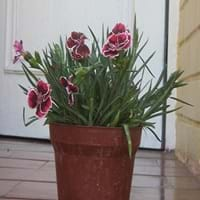Life Span
Perennial
Annual and Perennial
Type
Shrub
Tender Perennial
Origin
Eastern Asia, Japan
Hybrid origin, India
Types
Not Available
Dianthus chinensis, Dianthus deltoides
Habitat
Old fields, stream banks
meadows, Waste areas
USDA Hardiness Zone
4-8
8-11
Sunset Zone
A3, 2b, 3a, 3b, 4, 5, 6, 7, 8, 9, 10, 11, 12, 13, 14, 15, 16, 17, 18, 19, 20, 21, 22, 23, 24
A2, A3, H1, 1a, 1b, 2a, 2b, 3a, 3b, 4, 5, 6, 7, 8, 9, 10, 11, 12, 13, 14, 15, 16, 17, 18, 19, 20, 21, 22, 23, 24
Habit
Oval or Rounded
Cushion/Mound-forming
Flower Color
Yellow, Yellow green
Pink, Fuchsia
Flower Color Modifier
Not Available
Bicolor
Fruit Color
Red orange
Tan
Leaf Color in Spring
Light Green
Light Green, Blue Green, Gray Green
Leaf Color in Summer
Green
Light Green, Blue Green, Gray Green
Leaf Color in Fall
Purple, Orange, Burgundy, Crimson
Light Green, Blue Green, Gray Green
Leaf Color in Winter
Not Available
Light Green
Leaf Shape
Obovate
Elliptic
Plant Season
Spring, Summer, Fall, Winter
Spring, Summer, Fall
Sunlight
Full Sun, Partial Sun
Full Sun, Partial Sun
Growth Rate
Medium
Medium
Type of Soil
Clay, Loam, Sand
Loam, Sand
The pH of Soil
Acidic, Neutral, Alkaline
Acidic, Neutral
Soil Drainage
Average
Well drained
Bloom Time
Spring, Late Spring
Spring, Late Spring, Early Summer, Summer, Late Summer
Tolerances
Pollution, Drought, Salt, Soil Compaction
Drought
Where to Plant?
Ground, Pot
Container, Ground, Pot
How to Plant?
Seedlings
Divison, Seedlings
Plant Maintenance
Medium
Medium
Watering Requirements
Requires regular watering during dry weather
Needs watering once a week, Requires watering in the growing season
In Summer
Lots of watering
Lots of watering
In Spring
Moderate
Moderate
In Winter
Average Water
Average Water
Soil pH
Acidic, Neutral, Alkaline
Acidic, Neutral
Soil Type
Clay, Loam, Sand
Loam, Sand
Soil Drainage Capacity
Average
Well drained
Sun Exposure
Full Sun, Partial Sun
Full Sun, Partial Sun
Pruning
Remove damaged leaves, Remove dead branches, Remove dead leaves
Remove damaged leaves, Remove dead leaves
Fertilizers
All-Purpose Liquid Fertilizer
Compost, organic fertlizers, Water soluble fertilizers
Pests and Diseases
Red blotch, Sunken patches
Insects
Plant Tolerance
Drought
Drought
Flowers
Insignificant
Showy
Flower Petal Number
Single
Double
Foliage Texture
Medium
Fine
Foliage Sheen
Matte
Matte
Attracts
Birds
Bees, Butterflies, Insects
Allergy
Not Available
Asthma
Aesthetic Uses
Borders
Beautification, Bouquets, Cottage Garden, Hanging Basket, Landscape Designing, Showy Purposes
Beauty Benefits
Not Available
Not Available
Environmental Uses
Air purification
Air purification, Food for insects
Medicinal Uses
Anthelmintic, Antibacterial, Antiseptic, Cancer
No Medicinal Use
Part of Plant Used
Fruits, Leaves
Flowers
Other Uses
Used to make yellow dye
Decoration Purposes, Employed in herbal medicine, Showy Purposes, Used as Ornamental plant, Used for its medicinal properties
Used As Indoor Plant
No
Yes
Used As Outdoor Plant
Yes
Yes
Garden Design
Edging, Foundation, Hedges, Mixed Border, Rock Garden, Wall
Bedding Plant, Container, Cutflower, Feature Plant, Groundcover, Hanging Basket, Mixed Border, Rock Garden / Wall
Botanical Name
BERBERIS thunbergii
DIANTHUS
Common Name
Japanese Barberry
Dianthus, Garden Spice Fuchsia Dianthus
In Hindi
Japanese Barberry
Dianthus
In German
Thunberg-Berberitze
Dianthus
In French
Berberis thunbergii
Dianthus
In Spanish
Berberis thunbergii
Dianthus
In Greek
Japanese Barberry
Dianthus
In Portuguese
Japanese Barberry
Dianthus
In Polish
Berberys Thunberga
Dianthus
In Latin
Japanese Barberry
Dianthus
Phylum
Magnoliophyta
Tracheophyta
Class
Magnoliopsida
Magnoliopsida
Order
Ranunculales
Caryophyllales
Family
Berberidaceae
Caryophyllaceae
Clade
Angiosperms, Eudicots
Angiosperms, Eudicots
Tribe
Not Available
Caryophylleae
Subfamily
Not Available
Caryophylloideae
Number of Species
Not Available
Season and Care of Japanese Barberry and Dianthus
Season and care of Japanese Barberry and Dianthus is important to know. While considering everything about Japanese Barberry and Dianthus Care, growing season is an essential factor. Japanese Barberry season is Spring, Summer, Fall and Winter and Dianthus season is Spring, Summer, Fall and Winter. The type of soil for Japanese Barberry is Clay, Loam, Sand and for Dianthus is Loam, Sand while the PH of soil for Japanese Barberry is Acidic, Neutral, Alkaline and for Dianthus is Acidic, Neutral.
Japanese Barberry and Dianthus Physical Information
Japanese Barberry and Dianthus physical information is very important for comparison. Japanese Barberry height is 90.00 cm and width 120.00 cm whereas Dianthus height is 25.40 cm and width 25.40 cm. The color specification of Japanese Barberry and Dianthus are as follows:
Japanese Barberry flower color: Yellow and Yellow green
Japanese Barberry leaf color: Light Green
Dianthus flower color: Pink and Fuchsia
- Dianthus leaf color: Light Green, Blue Green and Gray Green
Care of Japanese Barberry and Dianthus
Care of Japanese Barberry and Dianthus include pruning, fertilizers, watering etc. Japanese Barberry pruning is done Remove damaged leaves, Remove dead branches and Remove dead leaves and Dianthus pruning is done Remove damaged leaves and Remove dead leaves. In summer Japanese Barberry needs Lots of watering and in winter, it needs Average Water. Whereas, in summer Dianthus needs Lots of watering and in winter, it needs Average Water.





